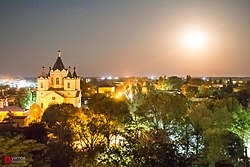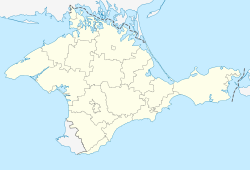Dzhankoi
Dzhankoi Джанкой Canköy | |
|---|---|
 | |
| Coordinates: 45°42′31″N 34°23′36″E / 45.70861°N 34.39333°E | |
| Country | |
| Autonomous republic | Crimea (de jure) |
| Raion | Dzhankoi Raion (de jure) |
| Federal subject | Crimea (de facto) |
| Municipality | Dzhankoi Municipality (de facto) |
| Area | |
• Total | 26 km2 (10 sq mi) |
| Elevation | 20 m (70 ft) |
| Population (2014) | |
• Total | 38,622 |
| • Density | 1,648.5/km2 (4,270/sq mi) |
| Time zone | UTC+3 (MSK) |
| Postal code | 96100 — 96114 |
| Area code | +7-36564 |
| Website | dzhankoy |
 | |
Dzhankoi or Jankoy[1] is a city of regional significance in the northern part of Crimea, internationally recognized as part of Ukraine, but since 2014 occupied by Russia. It also serves as administrative centre of Dzhankoi Raion although it is not a part of the raion (district). Population: 38,622 (2014 Census).[2]
The name Dzhankoi (Ukrainian and Russian: Джанкой; German: Dshankoj;[3] Crimean Tatar: Canköy; Yiddish: דזשאַנקויע) means 'new village': canköy < cañı köy (cañı is 'new' in the northern dialect of Crimean Tatar), but it is often explained as meaning 'spirit-village' (< can 'spirit' + köy 'village').
The city has various industries, which produce automobiles, reinforced concrete, fabric, meat, and other products. Dzhankoi also has professional technical schools.
Geography
Dzhankoi serves as the administrative centre of the Dzhankoi Raion. It is located about 93 kilometres (58 mi) from the Crimean capital, Simferopol. Two railroad lines, Solionoye ozero-Sevastopol and Armiansk-Kerch, cross Dzhankoi.
Climate
Dzhankoi's climate is mostly hot in the summer, and mild in the winter. The average temperature ranges from −2 °C (28 °F) in January, to 23 °C (73 °F) in July. The average precipitation is 420 millimetres (17 in) per year.
History
Dzhankoi was mentioned for the first time in 1855, and it received city status in 1926. About 1,400 Jews lived in Dzhankoi on the eve of the Second World War.[4] In 1941, during the war, Dzhankoi was occupied by German troops. During the occupation, 720 Jewish members of the local collective farm were shot in the city.[4] Other accounts mention 7,000,[5] which could include Jews brought from elsewhere.[6] Dzhankoi was recaptured by Soviet troops on April 13, 1944. In 1954, as part of the Crimean region, it became part of the Ukrainian SSR. Since 1991, it has been a part of independent Ukraine. In February 2014, it was annexed by Russia. On the night of March 20, 2023, explosions caused by drone attacks were reported in the area.[7]
Transport
Dzhankoi is a transport hub. Through the city pass two major railways of the peninsula as well as two major European highways. It has two railroad terminals - the central one, where only passenger and fast trains stop and the suburban one - where only suburban trains, known as elektrichkas, are allowed.
Dzhankoi air base of the Russian Navy is nearby.
Population
| Year | Inhabitants |
|---|---|
| 1805 | 173 |
| 1926 | 8,310 |
| 1939 | 19,576 |
| 1970 | 43,000 |
| 1989 | 53,464 |
| 2001 | 42,861 |
| 2014 | 38,622 |
Demographics
As of the 2001 Ukrainian census, 59.75% of the population identified as Russians, 25.91% as ethnic Ukrainians, while Crimean Tatars made up 8.09% of the population. The town is also home to smaller Belarusian, Polish, Moldovan and Armenian communities.[8]
In the 2014 census conducted by Russian occupation authorities, the town had a population of 38,622, of which 25,787 (66.77%) were Russian, 6,401 (16.57%) were Ukrainian, 2,807 (7.27%) were Crimean Tatar and 829 (2.15%) were Tatar.[9]
In popular culture
Dzhankoi is the subject of a popular Yiddish song "Hey! Zhankoye" (Yiddish: "Dzhankoye" "דזשאַנקויע"), as popularized by The Limeliters, Pete Seeger, the Klezmatics, and Theodore Bikel, a Soviet-era song praising the life of Jews on collective farms in Crimea.[10][11][12]
Gallery
- Stepna River in Dzhankoi
- City centre of culture
- Downtown Dzhankoi
- Street intersection in Dzhankoi
- Dzhankoi's train station
Notable people
- Oleksandr Mitrofanov (born 1977), Ukrainian football player
- Denys Vasyliuk (1993-2024), Ukrainian fighter pilot and Hero of Ukraine
References
- ^ "6 Kilogrammes of Mercury Found Out in the Centre of Jankoy in Crimea". Archived from the original on 2015-01-09. Retrieved 2014-04-04.
- ^ Russian Federal State Statistics Service (2014). "Таблица 1.3. Численность населения Крымского федерального округа, городских округов, муниципальных районов, городских и сельских поселений" [Table 1.3. Population of Crimean Federal District, Its Urban Okrugs, Municipal Districts, Urban and Rural Settlements]. Федеральное статистическое наблюдение «Перепись населения в Крымском федеральном округе». ("Population Census in Crimean Federal District" Federal Statistical Examination) (in Russian). Federal State Statistics Service. Retrieved January 4, 2016.
- ^ "Places where Mennonites lived in Russia up to 1943" (PDF).
- ^ a b Arad, Yitzhak (2009). The Holocaust in the Soviet Union. Jerusalem: Yad Vashem.
- ^ "Крым". Электронная еврейская энциклопедия. Retrieved November 17, 2022.
- ^ Megargee, Geoffrey P. (2012). The United States Holocaust Memorial Museum Encyclopedia of Camps and Ghettos. Volume II: Ghettos in German-Occupied Eastern Europe, 1933-1945. Bloomington, IN: Indiana University Press. p. 1765.
- ^ "Ukraine says Russia Kalibr missile cargo hit in transit to Crimea". Al Jazeera. March 21, 2023. Retrieved March 21, 2023.
- ^ "Національний склад міст".
- ^ "Crimea (occupied by Russia) - Ethnic composition: 2014 census" (in Ukrainian). Retrieved 7 July 2022.
- ^ Kann, Kenneth L. (1993). Comrades and Chicken Ranchers. Cornell University Press. pp. 87–88.
- ^ Silverman, Jerry (2010). Songs of the Jewish People. Mel Bay Publications. pp. 54–55.
- ^ "Video Archives: Yosl Kogan, Bershad Ghetto". AHEYM: Archives of Historical and Ethnographic Yiddish Memories. Indiana University (Bloomington), College of Arts and Sciences. Retrieved 27 February 2014.
External links
- The murder of the Jews of Dzhankoi during World War II, at Yad Vashem website.









